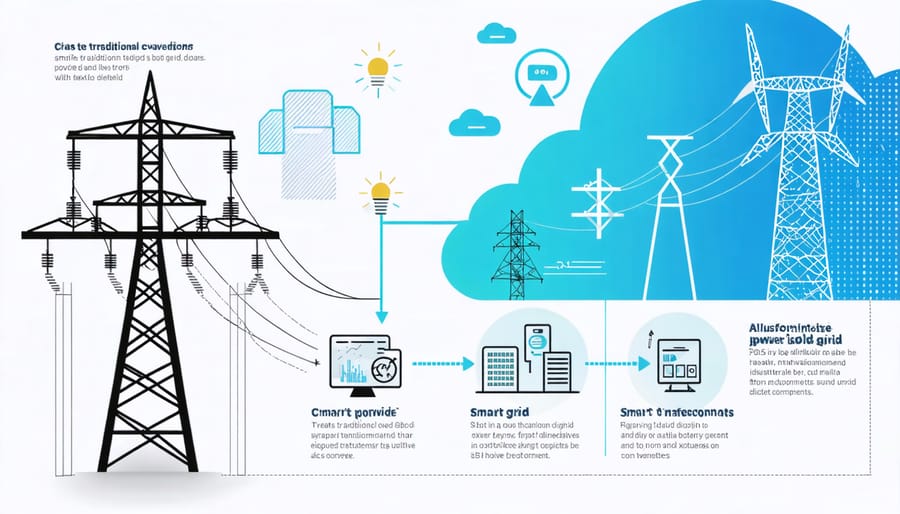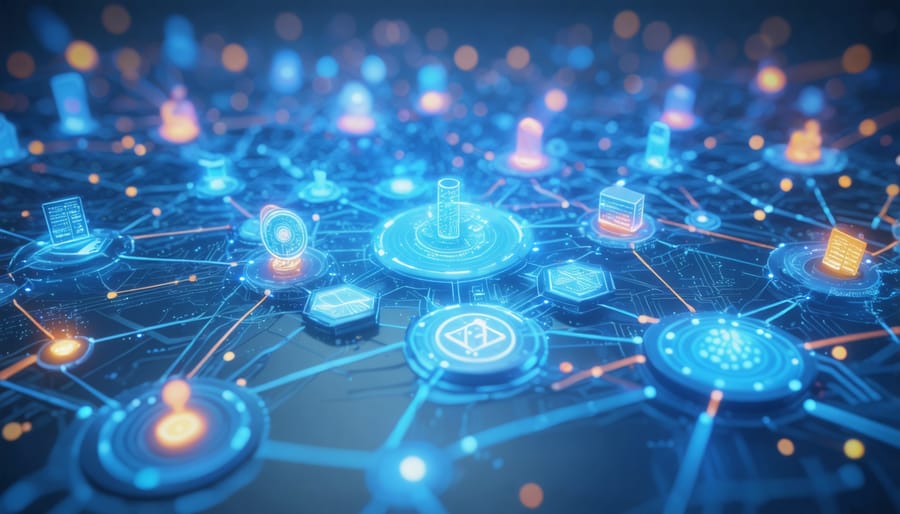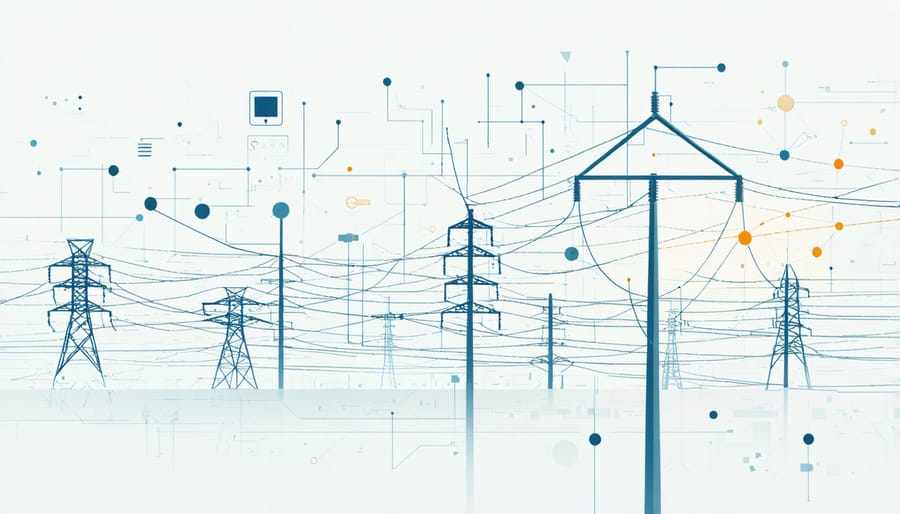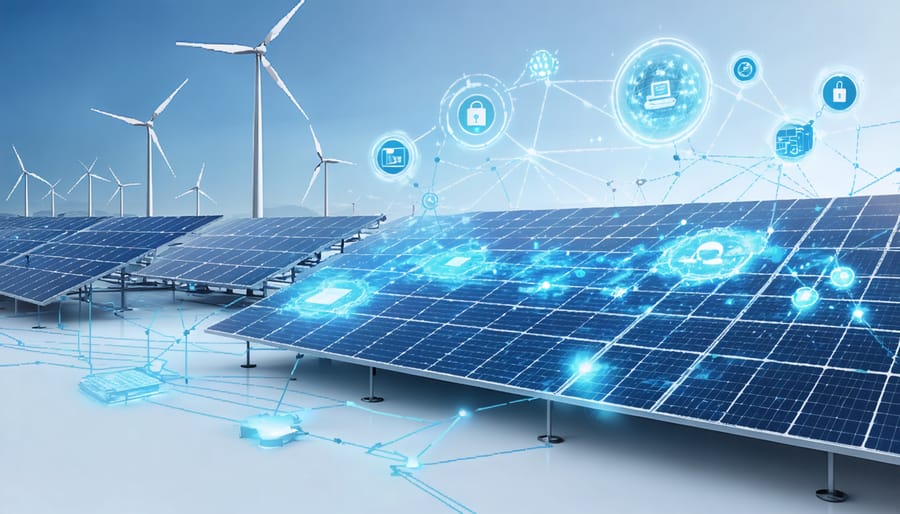Imagine a power grid that thinks, learns, and adapts in real-time – that’s smart energy in action. As Australia leads the global energy revolution, smart energy systems are transforming how we generate, distribute, and consume power, creating a more sustainable and efficient future. These intelligent networks combine renewable energy sources, advanced digital technologies, and automated systems to optimize energy flow, reduce waste, and respond instantly to changing demand patterns.
By integrating solar panels, wind turbines, and battery storage with sophisticated AI-driven monitoring systems, smart energy represents the convergence of traditional power infrastructure and cutting-edge digital innovation. This transformation isn’t just about technology – it’s about empowering consumers to take control of their energy usage while strengthening grid resilience against cyber threats and climate challenges.
From smart meters in suburban homes to industrial microgrids powering manufacturing facilities, this intelligent energy ecosystem is rapidly becoming the backbone of Australia’s sustainable energy future, promising reduced costs, enhanced reliability, and a smaller environmental footprint.

The Evolution of Smart Energy Systems
Key Components of Smart Energy
Smart energy systems rely on three fundamental components that work together seamlessly to create an efficient and sustainable power network. At the core are smart meters, which serve as the digital eyes and ears of the network. These intelligent devices enable real-time monitoring of energy consumption and help both consumers and utilities make informed decisions through smart energy monitoring systems.
Grid automation represents the second pillar, incorporating advanced sensors and automated controls that respond instantly to changes in energy demand and supply. This technology helps prevent outages, optimises power distribution, and maintains grid stability across Australia’s vast network.
The third essential component is renewable energy integration, which connects solar, wind, and other clean energy sources to the traditional grid infrastructure. Modern smart grids can efficiently manage the variable nature of renewables, storing excess energy during peak production and distributing it when needed. This integration is particularly crucial for Australia, where abundant sunshine and wind resources offer tremendous potential for sustainable power generation.
Together, these components create a responsive, efficient, and environmentally conscious energy ecosystem that’s transforming how we produce and consume power.
Australia’s Smart Energy Landscape
Australia is rapidly embracing smart energy solutions, with over 3 million households now equipped with rooftop solar systems. Smart meters are becoming increasingly common across major cities, helping residents monitor and optimize their energy consumption in real-time. State governments are actively supporting this transition through initiatives like Victoria’s Solar Homes Program and South Australia’s Virtual Power Plant scheme. Energy providers are rolling out innovative solutions such as demand response programs and time-of-use pricing, enabling consumers to save money while contributing to grid stability. Major cities like Sydney and Melbourne are implementing smart street lighting and building management systems, showcasing Australia’s commitment to creating an intelligent, sustainable energy future. The integration of battery storage systems and microgrids is also gaining momentum, particularly in remote communities, making Australia a leading example of smart energy adoption in the Asia-Pacific region.
Smart Energy’s Digital Infrastructure
Communication Networks
Communication networks form the backbone of smart energy systems, enabling seamless data exchange between various components. These networks operate like a well-orchestrated digital symphony, where smart meters, sensors, and grid infrastructure work together to share real-time information about energy consumption, production, and distribution.
In Australia’s smart energy landscape, multiple communication technologies come into play. Advanced Metering Infrastructure (AMI) uses secure wireless networks to transmit usage data from homes to utilities. Meanwhile, high-speed fiber optic networks connect larger infrastructure components, ensuring rapid response times and reliable data transmission across the grid.
The communication system typically operates on a hierarchical structure. At the neighbourhood level, mesh networks allow devices to communicate with each other, creating resilient local networks. These feed into wider area networks that connect to control centres, where sophisticated software analyses the data to optimise energy distribution and respond to changing demands.
This interconnected communication framework enables features like dynamic pricing, automated fault detection, and remote system management, making our energy infrastructure more efficient and responsive than ever before.

Data Management Systems
At the heart of smart energy systems lies sophisticated data management infrastructure that transforms raw energy data into actionable insights. These systems collect real-time information from various sources, including smart meters, weather stations, and grid sensors, creating a comprehensive picture of energy production and consumption patterns.
Modern data management platforms use cloud computing and advanced analytics to process this vast amount of information. Through AI-powered grid management, these systems can predict energy demand, optimize distribution, and identify potential infrastructure issues before they become problems.
In Australia, energy providers are increasingly adopting smart data management solutions to better serve their communities. These systems enable precise monitoring of renewable energy integration, help balance supply and demand during peak periods, and support more efficient grid operations. The data collected also helps consumers make informed decisions about their energy usage through user-friendly apps and dashboards.
Real-time monitoring capabilities allow grid operators to respond swiftly to changes in energy demand or supply disruptions, ensuring reliable power delivery while maximizing the use of renewable energy sources. This data-driven approach is crucial for creating a more resilient and sustainable energy future for Australia.
Vulnerability Points in Smart Energy

Common Attack Vectors
As smart energy systems become more interconnected, they face several potential security challenges that need careful attention. Remote access vulnerabilities can allow unauthorized users to manipulate energy distribution or consumption data. Malicious actors might target smart meters through data injection attacks, attempting to falsify readings or disrupt billing systems.
One significant concern is Distributed Denial of Service (DDoS) attacks, which can overwhelm smart grid components and potentially cause widespread outages. Man-in-the-middle attacks pose another threat, where attackers intercept communications between smart devices and control systems, potentially compromising sensitive data or sending false commands.
In the Australian context, ransomware attacks targeting utility providers have emerged as a growing concern, with cybercriminals attempting to encrypt critical systems and demand payment. Social engineering tactics, such as phishing emails targeting utility employees, can also provide entry points for more sophisticated attacks.
Physical security breaches at substations or access points can compromise both traditional and smart infrastructure components. Additionally, insider threats from disgruntled employees or contractors with system access remain a persistent risk that energy providers must address through robust security protocols and regular staff training.
To maintain system integrity, Australian energy providers continuously update their security measures and collaborate with cybersecurity experts to stay ahead of emerging threats.
Real-World Impact
The real-world consequences of smart energy cybersecurity incidents serve as powerful reminders of the importance of robust protection measures. In 2015, Ukraine experienced a watershed moment when cyber attackers successfully disrupted power distribution to over 230,000 residents, demonstrating the vulnerability of digital energy systems. Closer to home, Australian energy providers have reported increasing attempts to breach their smart grid infrastructure, with one major utility detecting over 150 suspicious activities in a single quarter of 2022.
These incidents have led to significant operational disruptions, financial losses, and compromised consumer data. For instance, a regional Victorian smart meter network breach in 2021 exposed usage data of approximately 10,000 households, highlighting privacy concerns in connected energy systems. However, these challenges have sparked positive change, with energy providers implementing more sophisticated security protocols and investing in advanced threat detection systems.
The silver lining is that each incident has contributed to stronger, more resilient smart energy networks. Australian energy providers now lead the way in implementing multi-layered security approaches, combining AI-driven monitoring, regular security audits, and comprehensive staff training programs to protect our evolving energy infrastructure.
Future-Proofing Smart Energy
As we look towards the horizon of smart energy development, future-proofing our systems becomes increasingly critical. Australia’s energy landscape is rapidly evolving, with emerging technologies reshaping how we generate, distribute, and secure our power networks. Innovation in artificial intelligence and machine learning is enabling predictive maintenance and real-time threat detection, while blockchain energy trading solutions are revolutionising how we manage and secure energy transactions.
Advanced encryption protocols and quantum-resistant security measures are being developed to protect against future cyber threats. These innovations are particularly crucial for Australia’s widespread energy networks, where remote monitoring and control systems must remain secure across vast distances. Industry leaders are also implementing zero-trust architectures and sophisticated identity management systems to ensure only authorised personnel can access critical infrastructure.
Looking ahead, the integration of edge computing and 5G networks will enhance system responsiveness while maintaining robust security. Smart sensors with built-in security features are becoming standard, creating multiple layers of protection against potential threats. The focus is shifting towards creating resilient systems that can not only defend against attacks but also recover quickly and adapt to new challenges.
To stay ahead of emerging threats, energy providers are fostering collaboration with cybersecurity experts and participating in regular security audits and updates. This proactive approach, combined with ongoing workforce training and development, ensures our smart energy infrastructure remains secure and reliable for generations to come.
Smart energy represents a pivotal shift in how we power our future, combining traditional infrastructure with cutting-edge digital technology. As we’ve explored, these systems offer tremendous benefits in efficiency, cost savings, and environmental impact. However, their reliance on interconnected networks makes cybersecurity absolutely crucial. By implementing robust security measures, regular system updates, and comprehensive staff training, we can harness the full potential of smart energy while protecting our critical infrastructure. Australia stands at the forefront of this energy revolution, and with continued focus on security alongside innovation, we’re well-positioned to create a more sustainable and resilient energy future. Remember, the success of smart energy systems depends not just on the technology itself, but on our commitment to protecting it while maximizing its benefits for all Australians.

